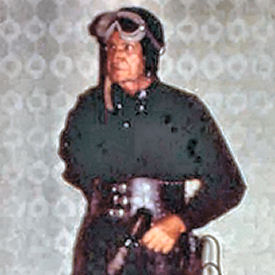
Quite coincidental with last week’s column—“coincidental” meaning I’m not taking credit for it—one of the Facebook groups I read and contribute to had a discussion about E.E. “Doc” Smith’s writing. It started quite innocently with a fan (I’m not gonna mention any names here, as it would be quite a task to get permission to quote from all the folks involved) saying “Anyone? I’ve never been able to read E. E. Smith’s books.” Now, if you read this column at least semi-regularly, you’ll know that not only was I a friend of the family, but I also have read and enjoyed pretty much everything Doc wrote (I’m just declaring my bias here so you’ll have all the facts). And from there the controversy raged, with fans, well-known and otherwise, authors (ditto) and both professional and fan artists all joining in the fun—as a matter of fact as I write it’s four days later and the comments are still flying.
There appear to be over a hundred comments at this time, ranging from “Smith was sub-par even by pulp standards. His only virtues were science-fictional ones, his ideation and the scope of his imagination. His narrative ability was not even on the level of the average pulp western or adventure writer. Thus when Smith tried to write outside of science fiction (some detective stories), he could not sell the result,” [from a well-known writer and editor]; to “Hey, you like what you like. It’s old, old school. Ever try reading Burroughs’s Tarzan? Even harder to read. Really,” [from another editor]; to “The Golden Age of Science Fiction is 12” [several people]. It’s really a fun discussion, no matter what your opinion of Doc’s writing is—you can take a stand and, at least to this point, nobody gets upset with your opinion, which is kind of rare for Facebook, which seems to often bring out the worst in people; the lack of vitriol here and relative kindness to each other seem to be fannish traits. Anyway, back to Doc’s virtues (or lack thereof) as a writer: even though I had just reread The Skylark of Space, I decided to see if I could go back and look at it with a more or less unjaundiced eye. Since I couldn’t find the paperback I read last week (Divesting, remember?) I decided to go to the Gutenberg version (the HTML one; see link above), even though Verna, Doc’s daughter, wouldn’t have liked my doing so.

What do you think I found, as a dedicated reader of Doc Smith? Let’s put it this way: Doc was no kind of literary stylist. Had we brought Doc in to one of the several writers’ groups (i.e., Writers’ Bloc, Writers of the Lost, Ink) I founded, our first advice to him would have been “Show, don’t tell.” In Skylark, Doc is constantly telling us how the characters felt, what they meant, and so on. Telling us how a character feels makes the story weaker (in many people’s opinion, not just mine), and that was probably the least of Doc’s literary sins.
But you know what? His story, and the characters’ actions, kept you reading—and that was probably one of the highest aspirations of magazine writers—since there was no “SF” category of books, per se at the time—and would not have been seen as a sin when it was written. Doc wasn’t trying to write “The Great American Novel,” he was at best trying to write “a whopping good yarn.” And that was fine with him—as you can see from Figure 1, where Doc was attending a Worldcon dressed (not for the first time) as C.L. Moore’s famous space opera character Northwest Smith—Doc didn’t take himself that seriously as a writer. So in my opinion, Doc was not a great stylist, not a terrific literary writer, but not a hack, either—the things he wrote were written as stories, not yet clichés, and were meant to be fun for the reader. And that’s good enough for me and untold thousands of his fans.

Last time, I reviewed Brain Twister, by Mark Phillips, and promised to review the second book in what I recently found out was a trilogy. (I may have read the third book, Supermind, back in the sixties, but if so, I’d forgotten it…so it will be reviewed in an upcoming column.) So here’s my review, a reasonably short one, of The Impossibles, by Laurence Mark Janifer and Randall Phillip Garrett. (Because the authors said their pseudonym was made up of their middle names, I’m guessing that Phillip was Garrett’s middle name, even though none of the usual sources confirm that.) Although John Schoenherr, the cover artist, is probably best known for his Dune covers, I really think the three “Mark Phillips” book covers are very well done too.
The Impossibles continues the adventures of intrepid F.B.I. Agent Kenneth J. Malone, who works with a man named Boyd. Both are members of the “Queen’s Own F.B.I.,” an organization within the Federal Bureau of Investigation, headed by Andrew J. Burris. The reason, if you haven’t read last week’s review, is that this particular branch of the F.B.I., based out of Yucca Flats, works for Queen Elizabeth I. The Queen, who is actually a little old lady named Rose Thompson, who is clinically insane and believes she is—not the reincarnation, which might make some sense—but actually Queen Elizabeth herself, an immortal—is a functioning telepath. In fact, all telepaths are insane; it’s part of being a telepath, but Rose—I mean the Queen—is able to function quite well in society as long as the people around her acknowledge her as Queen Elizabeth. There you go; clear as mud, I’m guessing. Anyway, she had assisted the F.B.I. in a previous case and had been set up in Yucca Flats, where everyone played to her insanity, because a functioning telepath can be of great use to a bunch of snoopy busybodies…I mean, to the Queen’s Own F.B.I.
These books are, naturally, very tongue-in-cheek; in fact, Malone isn’t one of the sharpest F.B.I. pencils in the case. In Brain Twister, Malone, Boyd and Burris were dealing with mind-reading spies; in this novel—even though Malone doesn’t get it for a while, we SF types know pretty early that they’re dealing with teleporters. In this case, it’s a gang of juvenile Hispanics who call themselves The Angels, led by Mike (Miguel) Fueyo. Because Malone spends a lot of time getting bopped on the head and so on, it takes him a while to catch on, but he eventually gets with the program. We’re not sure what happened to the zaftig blonde Sir Kenneth was lusting after in the previous book, but here he’s got his eyes set on a beautiful Hispanic woman named Dorothea Fueyo, who happens to be Mike’s sister. The usual sorts of complications ensue—and The Queen makes a brief appearance. It’s all very silly—the near-future 1970s, as envisioned by the 1960s, is nowhere near the 1970s we lived through; picture phones are still not ubiquitous; most men had quit wearing hats by the 1970s; smoking was beginning to be a social (and medical) no-no, and so on. But we can forgive Garrett and Janifer, who weren’t really out to foretell the future; they were just trying to write a fun little book. Which, for my money, they did. Oh, and for Leslie Charteris (The Saint) fans, there’s a nice little tribute; I won’t spoil it for you. Maybe not quite as much fun as the first one, but it did serve. I’d give it 3 or 4 whatchamacallits out of 5. You know, ¤s.

Moving on to the main attraction, we have a new book by Matthew Hughes (figure 4), which has only been out for a little while. It’s available from his website for a limited time for only 99 cents! Here’s the book’s description:
In an age of wizards and walled cities, Raffalon is a journeyman member of the Ancient and Honorable Guild of Purloiners and Purveyors. In other words, a thief.
His skills allow him to scale walls, tickle locks, defeat magical wards. He lifts treasures and trinkets, and spends the proceeds on ale and sausages in taverns where a wise thief sits with his back to the wall.
But somehow things often go the way they shouldn’t and then Raffalon has to rely upon his wits and a well calibrated sense of daring.
Here are nine tales that take our enterprising thief into the Underworld and Overworld, and pit him against prideful thaumaturges, grasping magnates, crooked guild masters, ghosts, spies, ogres, and a talented amateur assassin.

All but one of these stories has previously been published, most if not all in F&SF. The ninth was specifically written for this volume. Here’s the great thing about the Raffalon stories—if you have read and enjoyed any Jack Vance Cugel stories, or Fritz Leiber’s Fafhrd and the Grey Mouser stories, you’ll probably get a kick out of these tales. The stories are—as so much fantasy seems to be–set in a nebulous world with monsters, gods, wizardry (swords and sorcery) that is at the same time sort of medieval.
Raffalon is a thief, as it says above; a “journeyman member of the Ancient and Honourable Gild of Purloiners and Purveyors.” He’s kind of unprepossessing in appearance—no thief (or purloiner) wants to be especially memorable—except for his nose, which is (as Paul’s granddad said of Ringo’s) “a monstrous great hooter.” The nose does have a part to play in one story, which is why I mention it. Raffalon is skilled at all the things listed above—but he’s not necessarily the most skilled purloiner around. (I believe that at one point it’s mentioned that he was at the bottom of his class at the Academy…or wherever thieves learn their trade.) Like many thieves, he lives from score to score; he has no fixed abode, but travels from city to city as each one becomes, in turn, too hot for comfort (“hot” in the sense of “They’re coming to get you, Barbara,” “they” in this case being the authorities of whatever sort that rule over each city). But Raffalon “don’t get no respect,” as Rodney Dangerfield used to say; something often goes wrong with his “big score,” and he finds himself forced to flee…if not for his life, for his freedom. These stories seem to be entirely self-consistent; the character is one you can empathize with, if not actually sympathize (most of the time), and I found them to be a lot of fun to read. I don’t often give out five thingamajigs, but I think this one deserves a big five ¤s. Highly recommended.
LAST WORDS: Two weeks ago, there was a “giant wardrobe sale” here (“10,000 items!”) for the TV show Lucifer. I didn’t attend, because even if I were a hipster, which I’m not, none of the wardrobe items would probably have fit me (I’ve grown somewhat around my personal equator in the last 30 years). I mention this sale, because thanks to our Liberal Party government, the tax breaks and discounts for TV and movie productions have been lowered or eliminated, so Lucifer—just one of the many TV shows and movies filmed here in Vancouver and British Columbia (like Supernatural, Supergirl, The Flash, etc.)—is moving to LA. It’s a crying shame, because not only is it cool to live in what’s been dubbed “Hollywood North,” and to occasionally encounter actors, filming, etc., on the street, but each production puts an enormous amount of money into the local economy.
It’s the Provincial government being penny wise (“We’re saving money and balancing the budget by cutting tax breaks!”) and pound foolish, due to the financial losses suffered by local unions, suppliers, merchants, actors and local taxes paid by these productions. (I did go to the Prison Break prop sale—hoping to buy back the bot of my wife’s (the Beautiful and Talented Lynne Taylor Fahnestalk) that the production had bought and aired in Season 3, episode 1, but no luck; but because a lot of the production was done in Morocco, there was a surfeit of Arabic signs, fake palm trees, clothing worn by people in middle-east prisons, and stuff I had no interest in.) Anyway, I just wanted to put in my two cents’ worth about financial short-sightedness. (Not that I’m any kind of expert on fiduciary responsibility, but then, lack of qualification never kept anyone from having—and voicing—an opinion, eh? Especially on the internet.)
If you have the interest or the desire, please comment on this week’s column. You can comment here, or on my Facebook page, or in the several Facebook groups where I publish a link to this column. Your comments are all welcome, pro or con. And don’t feel you have to agree with me to post a comment, either. And my opinion is, as always, my own, and doesn’t necessarily reflect the views of Amazing Stories or its owners, editors, publishers or other columnists. See you next week!











Got the PayPal receipt toot-suite.
Been 30 minutes, no PDF or other e-mail.
Robert: I have no idea what this reply refers to. Can you clarify, please?